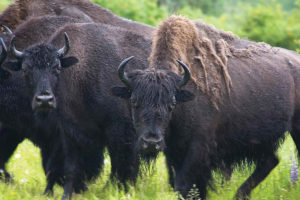Late in the 19th century, in a frenzy lasting little more than a decade, 15 million bison were slaughtered on the Great Plains. This fact is well known, but there is disagreement over why the decimation occurred, and no explanations for why it happened so quickly. Recent research by M. Scott Taylor (2011) shows that both the origin and speed of the slaughter are traceable to an innovation in tanning that opened the huge European leather market to North American bison hides.
Sixteenth century North America contained 25–30 million bison. By 1850, subsistence hunting and habitat destruction had removed all of the bison east of the Mississippi, leaving perhaps 15 million on the Great Plains. Over the years 1871–1884 this population was slaughtered, with most of the carnage occurring by 1879. Only a few hundred animals survived on the Plains, all on private ranches. Taylor shows that the magnitude and speed of the devastation were directly linked to two key factors: an innovation in tanning that sharply raised the commercial value of bison hides, and a huge European market able to absorb a million or more hides a year at roughly constant prices.
Prior to 1870, hunting pressure on bison west of the Mississippi was modest. Plains Indians effectively managed bison herds as common property, engaging in subsistence hunting and in harvesting the vaunted “buffalo robe” (used for carriage throws and heavy fur coats) for sale to eastern markets. Though the robes were valuable, they could be harvested only in the winter and only from bison living in high northern latitudes—an arduous and risky undertaking at best. Hence, the western bison continued to thrive.
In the early 1870s, however, a cheap commercial process for tanning bison hides was developed in England and Germany. Bison hides from which the hair had been removed (called flint hides) were superb for making the soles of boots and industrial belts. European armies and factories were a huge market, and within months of the tanning innovation, orders for bison hides poured into America. The price that hunters received for a flint hide jumped from $0 in 1870 to about $2.80 in 1871, and stayed in the range of roughly $2.30–2.80 for the next 15 years. A good hunter could bring several thousand hides to market in a season, but could expect pay of only about $50 per month as a ranch hand. It is little surprise then, that many hundreds of men quickly entered the business of hunting bison. The slaughter had begun.
The 1849 discovery of gold in California initiated a relentless stream of prospectors and other settlers through the Platte River Valley. Heavy subsistence hunting along the trail divided the existing bison herd into separate Southern and Northern herds. Construction of the Union Pacific through the valley in the 1860s made the division of the herd permanent, as the wary bison simply evacuated the railroad corridor.
When intensive commercial hunting began in 1871, it focused on animals in southern Nebraska and Kansas, those closest to the railroad. The elimination of the three million head there led hunters further south into what is now Oklahoma, western Texas, and eastern New Mexico. By 1879 the Southern herd was gone, the hides shipped to the tanneries of Europe. The Northern herd initially survived, effectively protected by the hostile Sioux. But after Custer’s defeat in 1876, the U.S. Army began a concerted—and successful—campaign against the Sioux. Northern Pacific railroad construction followed the army west from Bismarck, and hunters soon flooded the Dakotas, Wyoming, and Montana. Hunting of the Northern herd rapidly accelerated, and by 1884 the last of the flint hides was shipped out. The slaughter was over.
A striking feature of the process is that the price of bison hides remained remarkably stable, despite the surge and subsequent collapse of hide production. Over the years 1871–75, the price to hunters varied little from an average of about $2.80. And although hide prices dropped to about $2.30 in 1876, they stayed close to this through the end of the hunt. Of particular note, hide prices did not rise as either the Southern or the Northern herds were depleted. Taylor attributes the remarkable constancy of hide prices to two facts. First, in applications such as sole leather, harnesses, and industrial belts, bison hides were a good substitute for cattle hides. Second, while the bison hunt had a profound impact on the American Plains, the harvest was easily absorbed by the massive European market, where cattle hides outnumbered bison hides by 25 to 1.
The stable price of hides, combined with the fact that, as P.J. Hill (2011) notes, it was prohibitively expensive to move live bison to eastern markets, doomed the once-vast herds to become boots and belts, a relic of the past. That the species did not become extinct is due only to the vision of a few entrepreneurial ranchers, who protected the remaining handful of bison for their amenity value. Once 20th century innovations in trucking slashed the costs of getting bison to the dinner table, commercial herds grew quickly, now numbering some 500,000 head. And thus, just as the market brought the bison to near extinction, so too has it brought them back from the brink.
REFERENCES
Hill, P.J. 2011. http://percolatorblog.org/2011/05/13/the-non-tragedy-of-the-bison-commons/.
Taylor, M. Scott. 2011. Buffalo Hunt: International Trade and Virtual Extinction of the North American Bison. American Economic Review. 101(5): 3162-95.




